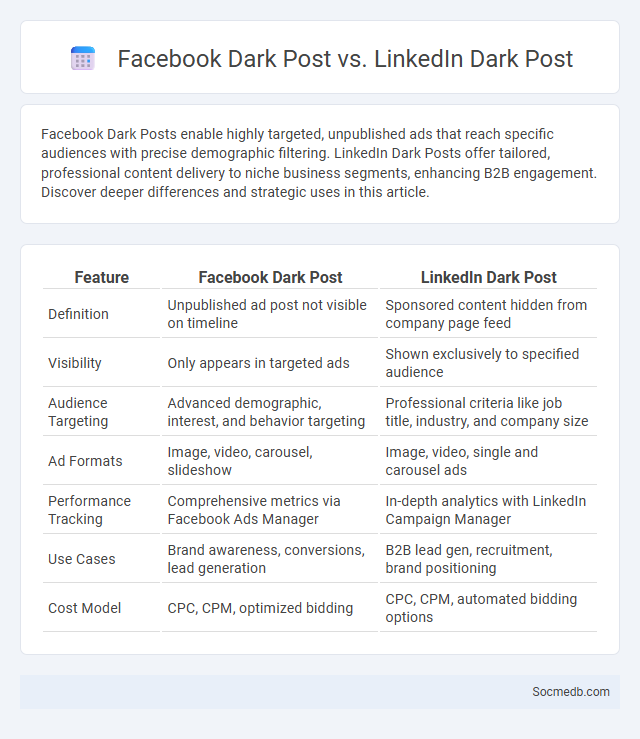
Photo illustration: Facebook Dark Post vs LinkedIn Dark Post
Facebook Dark Posts enable highly targeted, unpublished ads that reach specific audiences with precise demographic filtering. LinkedIn Dark Posts offer tailored, professional content delivery to niche business segments, enhancing B2B engagement. Discover deeper differences and strategic uses in this article.
Table of Comparison
| Feature | Facebook Dark Post | LinkedIn Dark Post |
|---|---|---|
| Definition | Unpublished ad post not visible on timeline | Sponsored content hidden from company page feed |
| Visibility | Only appears in targeted ads | Shown exclusively to specified audience |
| Audience Targeting | Advanced demographic, interest, and behavior targeting | Professional criteria like job title, industry, and company size |
| Ad Formats | Image, video, carousel, slideshow | Image, video, single and carousel ads |
| Performance Tracking | Comprehensive metrics via Facebook Ads Manager | In-depth analytics with LinkedIn Campaign Manager |
| Use Cases | Brand awareness, conversions, lead generation | B2B lead gen, recruitment, brand positioning |
| Cost Model | CPC, CPM, optimized bidding | CPC, CPM, automated bidding options |
Introduction to Dark Posts
Dark posts on social media refer to unpublished, targeted ads that do not appear on a brand's public timeline but are visible only to specific audience segments. These posts enable advertisers to tailor content precisely, enhancing engagement rates and reducing ad fatigue by avoiding repetitive exposure to a broader audience. Platforms like Facebook and Instagram utilize dark posts extensively for micro-targeting in campaigns, optimizing ad performance through segmented reach and personalized messaging.
What is a Facebook Dark Post?
A Facebook Dark Post is an unpublished ad that doesn't appear on your public Facebook page timeline but targets specific audiences based on detailed demographics and interests. These ads enable precise marketing strategies by appearing only in the News Feeds of selected users, maximizing engagement and conversion rates without cluttering your page's organic content. Using Facebook Dark Posts allows You to tailor messages discreetly, optimizing your social media advertising campaigns for better ROI.
Understanding LinkedIn Dark Posts
LinkedIn dark posts enable targeted content delivery by allowing advertisers to create non-public sponsored updates visible only to specified audiences via LinkedIn's Campaign Manager. These posts do not appear on the advertiser's LinkedIn page but can boost engagement and conversions through precise demographic, industry, and job-function targeting. Understanding LinkedIn dark posts enhances campaign effectiveness by leveraging hidden promotion strategies tailored to professional networking and B2B marketing goals.
Dark Posts: General Definition and Usage
Dark posts on social media refer to unpublished or non-organic ads that do not appear on a brand's public timeline but are targeted to specific audiences. These posts enable advertisers to run multiple variations of content simultaneously without cluttering their main profile, allowing for precise audience segmentation and A/B testing. Brands commonly use dark posts to optimize ad performance, increase engagement, and maintain a curated public presence while reaching niche demographics.
Key Differences Between Facebook and LinkedIn Dark Posts
Facebook dark posts target broad consumer audiences using detailed personal data for highly visual, engaging ads optimized for conversions and brand awareness. LinkedIn dark posts focus on professional segments by leveraging job titles, industries, and company size, delivering B2B content designed to generate leads and foster professional relationships. The platforms' ad formats and objectives differ, with Facebook prioritizing entertainment and shopping, while LinkedIn emphasizes networking and career growth.
Platform-Specific Targeting Options
Social media platforms offer platform-specific targeting options that enable advertisers to reach highly relevant audiences based on demographics, interests, behaviors, and location. Facebook provides detailed targeting through custom audiences, lookalike audiences, and interest categories, while LinkedIn specializes in professional targeting such as job title, industry, and company size. Instagram leverages visual content engagement and influencer partnerships to refine targeting, and Twitter focuses on keyword targeting and follower lookalikes for real-time audience engagement.
Ad Performance and Analytics Comparison
Social media platforms offer diverse ad performance metrics that vary significantly between Facebook, Instagram, and Twitter, with Facebook providing the most comprehensive analytics dashboard for tracking conversion rates, click-through rates, and audience engagement. Instagram's ad analytics excel in visual content insights and influencer campaign effectiveness, while Twitter emphasizes real-time data on tweet impressions and hashtag performance. Effective ad performance analysis requires leveraging platform-specific analytics tools such as Facebook Ads Manager, Instagram Insights, and Twitter Analytics to optimize ad spend and enhance campaign ROI.
Best Practices for Creating Effective Dark Posts
Targeting specific audience segments with tailored messaging enhances the relevance and engagement of dark posts on platforms like Facebook and Instagram. Utilizing A/B testing for headlines, images, and calls-to-action allows marketers to optimize performance based on real-time data analytics. Incorporating clear and compelling visuals alongside concise, actionable copy drives higher conversion rates while maintaining brand consistency and compliance with platform guidelines.
Compliance and Transparency Considerations
Social media platforms require strict adherence to compliance regulations such as GDPR, CCPA, and FTC guidelines to ensure legal accountability and protect user data. Transparency considerations include clear disclosures about data collection, targeted advertising, and partnership affiliations to maintain user trust. You must implement transparent privacy policies and compliance measures to mitigate risks and enhance your brand's credibility.
Choosing the Right Platform for Your Dark Post Strategy
Selecting the right social media platform for your dark post strategy requires analyzing audience demographics, engagement patterns, and platform-specific advertising tools. Facebook and Instagram offer advanced targeting options ideal for B2C campaigns, while LinkedIn excels in B2B lead generation through professional audience segmentation. Tailoring your dark posts to the platform's unique algorithm and user behavior enhances visibility and maximizes ROI.
 socmedb.com
socmedb.com